-
How To Manage Black Cockroach Infestation In Your Home
August 18, 2021
Black cockroach is a "giant" roach species that is considered the filthiest. Popularly known as Oriental cockroach, black roaches like…
Black cockroach is a “giant” roach species that is considered the filthiest. Popularly known as Oriental cockroach, black roaches like inhabiting dark, moist places. That is why they are also called “water bugs”. You will find them in all kinds of damp locations, including drains and sewers. Black cockroaches access homes through spaces under doors and gaps beneath sidings. Their dark, glossy bodies easily distinguish them from other kinds of roaches.
Black Roach Body Appearance
Probably, you are used to brown cockroaches. But are cockroaches black too? As their name indicates, black roaches are black with a shiny look. Males have wings covering almost three-quarters of their abdomens, leaving some abdominal parts exposed. Even though the males have wings, they do not fly. Females are wingless but have massive wing pads covering some aspects of their bodies. They are also larger than their male counterparts. Lengthwise, males can grow up to 25 mm long, while females can reach 32 mm in length. Black cockroaches are oval-shaped and have six legs plus two antennae.

Life Cycle Of Black Roaches
Like other cockroach species, a black roach passes through three metamorphosis stages – egg, nymph, and adult. Adults can live for one to six months and mate several times in their lifetime. Females lay more eggs during summer and spring when the weather is warmer.
Why Do Black Cockroaches Infest Homes?
Outdoors, black cockroaches reside under stones, debris, and leaf litter. Indoors, you will find them in crawl spaces, wall corners, floor drains, and basements. They also tend to move along water pipes to move up buildings. In most cases, they get attracted to homes because of the availability of food, particularly starchy food. Black roaches will, therefore, invade your house as long as there is an entry point and abundant food. They will also come inside searching for moisture if the conditions outside get too dry or too hot.
Common Black Roach Habits
Black roaches eat almost everything they can find, with their favourites being garbage, starchy items, and decaying organic matter. Surprisingly, they can go for a month without food. However, they cannot survive without water for more than two weeks. They heavily rely on water and will gather in plenty close to water sources.
Signs Of A Black Cockroach Infestation
One tell-tale sign of black cockroach infestation is finding cockroaches gathered in moist places, mulch, or under gutters. Another significant sign is spotting tiny feces or dark brown egg capsules indoors. These roaches also give off a musty/mouldy smell that is easy to identify when entering the house. The weird odour is what they use to communicate with each other. Since black cockroaches are primarily nocturnal, identifying them can be challenging. But when you see even a single one during the day, know that your house has been massively infested.
Problems Caused By Black Cockroaches
While black cockroaches rarely bite, they can do so with large infestation and scarce food. Their bites are painless and small but should be avoided. When it comes to carrying and transmitting germs, black roaches are the most notorious. Their need for water makes them visit sewers and other water sources full of bacteria. In addition, they like feeding on garbage and rotting food. They then transfer all that nasty stuff to utensils, meals, and countertops. Black roaches are known to be spreaders of E. coli and causers of dysentery and food poisoning. Allergens that trigger asthma symptoms and allergic reactions also accumulate in the droppings, cast skins, and dead bodies of these insects.
How To Prevent A Black Cockroach Infestation
The ideal way to prevent black roach infestation in your home is by eliminating the conditions attracting them. Here are some of the ways to make your home unconducive for cockroach infestation:
- Minimise moisture around your home by ensuring that gutters are draining correctly. Also, repair or replace all leaky fixtures.
- Utilise dehumidifiers in basements, crawl spaces, and other indoor areas with high humidity.
- Dispose of leaves, debris, and other garbage on your property.
- Seal all crevices and cracks in your house.
- Keep your pantry and kitchen free of spills, crumbs, and grease.
- Practise good home sanitation through regular vacuuming.
Eliminating Black Cockroaches Entirely
If black roaches already infest your home, you need to eliminate them immediately before the infestation goes out of control.
-
Provide Them What They Want
When you see one black roach, be sure there are hundreds of others in hiding. The best way to get rid of them is by using bait. Place a bait every four feet where cockroaches are prevalent. Each bait station should have water and food to attract roaches. Make sure to spike the attractants with an insecticide that kills cockroaches. Black cockroaches will get attracted, eat up and crawl away, sharing the feast with their counterparts, thus eradicating the entire group. An efficient bait can attract cockroaches for up to six months.
-
Spray Them Dead
To kill black cockroaches instantaneously, consider spraying them with a home-friendly, easy-to-use spray. An effective spray will terminate them on contact.
-
Regulate Their Growth
Insect Growth Regulators (IGR) are insecticides used to disrupt and impede the life cycle of insects by preventing reproduction, egg-hatching, and moulting. In this case, it ensures that black cockroach remain young and unproductive. IGR manages to control the population of cockroaches by eliminating the current infestation and preventing future infestations. Available in pest control stores, IGR comes in three forms – tablet, aerosol and concentrated liquid.
What’s The Difference Between A Water Bug And A Cockroach?
To best apply the above methods to prevent and control black roach, it is good to know how to differentiate them from water bugs.
- A water bug is an aquatic creature, meaning it lives entirely in water, unlike a cockroach.
- A water bug bite is painful, while that of a cockroach is not. However, both rarely bite unless provoked.
- Roaches feed on almost everything they encounter, whereas waterbugs are primarily carnivores and eat frogs, fish, and other insects.
Book a pest inspection
Get in touch with our Adelaide pest control office or Gold Coast pest control office for help with cockroaches, water bugs and all other pest inspection and extermination needs.
-
What Is A Baby Roach?
August 18, 2021
When you find baby cockroaches in your home, this is a sign of a significant infestation. It is an indication…
When you find baby cockroaches in your home, this is a sign of a significant infestation. It is an indication that adult cockroaches have already found a breeding spot in your residence. The term baby roach is used to describe cockroaches in the nymph stage. Despite being tiny, nymphs are still a nuisance, and you will find them in dark, moist areas with ample food availability. Here is more information about baby roaches to enable you to identify and eliminate them.
Where Do Baby Roaches Come From?
A baby roach comes into existence once a cockroach egg hatches. After that, they develop adult features slowly by slowly. They shed skin severally throughout moulting, and with each moult, they grow bigger. After each moult, they are highly vulnerable mainly because the new skin is susceptible to extreme conditions. During the nymph stage, a baby cockroach goes through colouration, depending on its species.
What Do Baby Roaches Look Like?
Female cockroaches typically lay around 48 eggs at a time. That leads to a high population of cockroaches, making them a real problem if they infest your home. The mother either hides the egg sac somewhere safe or carries it around. Nymphs or baby roaches generally hatch after 28 days. Then, they undergo moulting as they grow bigger. A baby roach usually matures after two months. All roach species moult, during which their colour and size change until they reach adulthood.

The stage a roach is in its life cycle determines its colour. On hatching, roaches are white. But after a few hours, they begin developing dark or light brown pigmentation like the adults. Each cockroach species has a different colour and markings on its body. For instance, a German roach has double black stripes from the head to the wings. Brown-banded cockroaches have yellow lines across their abdominal region. An American roach nymph is greyish brown before changing to a reddish hue. Young oriental cockroaches have darker bodies than adults and feature a tan stripe on their back.
Size Of A Baby Cockroach
Species determine size. Brown-banded and German baby roaches measure about 3 mm. Oriental nymphs are approximately 6 mm, while the American ones average a quarter-inch long. Never belittle a baby roach due to its small size. Regardless of their size, cockroaches pose a substantial threat anyways. No matter how small they are, they can still contaminate food and be challenging to control. While giant roaches look more intimidating and troublesome, watch out for the tiny ones too.
How Long Do Roaches Stay Babies?
Like most other pests, cockroaches moult severally before maturing into adulthood. The transition or the time between each moulting phase is known as an instar. A baby roach habitually goes through 6 to 7 instars before it becomes an adult. Depending on the environs and species, the moulting process takes 40 to 160 days.
Do Baby Cockroaches Fly?
Baby roaches have undeveloped wings, so they cannot fly. However, they can move pretty fast when they are under threat. They will hurry away or jump. Smaller cockroaches can squeeze their bodies through tiny openings and hide in hard-to-reach spots.
What Does It Mean If You Find A Baby Roach In Your Home?
Bathrooms, kitchens, and food stores offer an excellent environment for cockroaches to breed and live. Therefore, finding baby cockroaches is an indication of a massive infestation. There cannot be only one nymph in your residence. Female roaches reproduce very fast, laying around 50 eggs per egg case, depending on the species. During their lifetime, they can produce between 6 to 30 egg cases. Their short lifespan is more of an incentive to reproduce significantly in a short timeframe causing an enormous infestation. Bear in mind that when baby roaches fully grow, they also begin producing, making the cockroach population keep growing on a massive scale. And the bigger the population, the harder it is to manage.
How Many Babies Can A Cockroach Have?
Even though German cockroaches are smaller than their American counterparts, they make up for their small size by having lots of babies. Their egg cases contain 30 to 40 eggs, twice as much as what American roaches lay. They, therefore, get more than three hundred babies compared to American cockroaches that get about half that throughout their life. A German cockroach also has more babies because they carry their eggs along with them until they hatch, thus improving their babies’ survival chances.
How Dangerous Are Baby Cockroaches?
Besides being a sign of significant infestation, baby roaches cause many problems. They feed on rotten things, meaning they could be carrying germs that they can then transfer to your food. Roaches also defecate, spreading pathogens through their feces. Consequently, they put you at high risk of food poisoning without your realisation. Additionally, cockroaches shed skin, especially during moulting, whereby baby cockroaches are actively growing. The cast skins may contain allergens that can cause allergic reactions or trigger asthma symptoms when they get airborne.
How To Get Rid Of Baby Cockroaches
Given the problems baby roaches cause, you need to eliminate them immediately before they become adults. The most effective way to exterminate them is by enforcing comprehensive pest management. Such an approach involves insecticides application plus current and future prevention of infestation.
-
Apply Insecticide Spray
An aerosol spray containing insecticide works instantaneously when it comes to managing baby cockroaches both outdoors and indoors. Insecticide sprays are a quick way to attack and kill roaches instantly. The only downside is that sprays can be hazardous. But you are good to go as long as you wear protective gear such as gloves, a mask, and goggles to avoid direct contact. Reapply the spray until all the cockroaches are exterminated.
-
Baits
Baiting is another fantastic way to do away with baby cockroaches. Baits are available in various forms, including powder, gel, liquid, and granules. Position a bait where roaches frequently crowd or pass. Some of the places of high cockroach activity include near nests, inside kitchens, and behind cabinets. A good bait will work for several months and show results within a week. Granular baits are best suited for application around the perimeter of your house or garden. Once a cockroach feeds on the bait, a slow-acting insecticide takes effect, killing the bug a few hours later.
-
Boric Acid
Are you looking for a potent home remedy to keep small roaches at bay? Boric acid is a DIY method that involves mixing equal amounts of sugar, boric acid, and flour to create a dough. Make tiny balls from the dough and place them strategically around your house for baby cockroaches to eat. The sugar and flour will attract cockroaches, with the boric acid terminating them.
-
Hire A Professional
To get foolproof results, make sure to hire pest control experts. They are knowledgeable about what they specialise in, which is effectively managing pest infestations. So, be confident of getting rid of baby roaches in your home when you work with professionals. Due to their vast experience dealing with all kinds of pests, including cockroaches, they can identify and eliminate them promptly. In addition to eliminating bothersome pests, they put measures in place to ensure your home is not re-infested.
-
-
What Does A Cockroach Look Like?
August 18, 2021
Cockroaches are one of the most common pests in homes. They have been around for millions of years in almost…
Cockroaches are one of the most common pests in homes. They have been around for millions of years in almost every part of the world except Antarctica. Roaches are hardcore, adaptable creatures that can survive in most environments and conditions. In this guide, we present you with more understanding about cockroaches with a better focus on their looks. By knowing how roaches look, it becomes easy for you to identify and control them.
What Is A Cockroach?
Roaches belong to an order of insects known as Blattodea that also contains termites. Cockroaches are social creatures that live together in groups. Therefore, when you spot one cockroach, know that there are many others in close vicinity. The central part of a cockroach’s life involves seeking shelter and scavenging for food. That is why roaches are common in indoor environments where they invade searching for food, moist areas, and safe hiding places. Another thing about cockroaches is that they are nocturnal, meaning they mostly come out at night.
What Do Roaches Look Like?
It can be challenging to recognise a cockroach, mainly due to its close resemblance to water bugs and beetles. So, what distinguishes roaches from other look-alike bugs?
-
Flat Body
Cockroaches have flat bodies that they use to their advantage. The flat body enables them to wiggle through the smallest of spaces, eventually accessing your house. That also means they can comfortably hide in hard-to-reach areas and get the food they need wherever it is kept, becoming a nuisance inside your residence.
-
Brown Colour
Most roaches feature a brown pigment but with some distinction depending on the species. For instance, oriental cockroaches are more of little black roaches due to their dark hue. Other cockroach species are brown, featuring either black stripes behind the head like the German cockroach or a brown mark at the back of the head like the American cockroach.
-
How Many Legs Does A Cockroach Have?
Cockroaches are insects, so they have six legs. Their legs are spiny, slender, and jointed. The three pairs of legs are attached to the thorax. The first pair is made up of prothoracic legs, which are the shortest and used to brake. Mesothoracic legs are found in the middle and help the cockroach adjust speed by slowing down or speeding up. At the back are metathoracic legs that are the strongest and assist in moving forward at high speed. Now you know what enables cockroaches to run that fast.
-
Tough Body
Roaches have a hard-shelled body for ample protection. Their head faces upwards as they are always looking for food. An armoured shell, therefore, protects their head from knocks. Some cockroach species have wings, an added layer of protection, which fold down over their back.
-
How Large Are Cockroaches?
Cockroaches differ in size depending on species and stage of development. All have an oval shape, but weight and length vary. For example, a German cockroach is one centimetre long, while the Madagascar hissing roach can measure up to three inches in length. The giant burrowing cockroach weighs up to 35 grams, making it the heaviest roach.
-
Baby Roach Appearance
Baby cockroaches are distinct from adults. Therefore, it is wise to recognise them as well since they also pose a significant threat. They are small in size and do not have wings. Compared to the adults, they are lighter in colour. The light colour is more prominent after going through a moult. Baby roaches that have just moulted are cream to white, but their exoskeleton turns darker and harder with time.
What Do Cockroaches Eat?
Roaches are omnivores, meaning they feed on both animal and plant matter. They are not picky eaters and can eat anything from bread and fruits to meat and veggies. Additionally, they have a massive appetite for rotting stuff, soap, makeup, dead skin, and eyelashes.
Where Are You Likely To See Cockroaches?
A roach can survive in nearly all types of environments. You will typically find cockroaches living in areas where food and water are available, like the fridge, pantry, sink, and underdrain. Their flat body makes them fit in the tiniest of spaces.
Features Shared By All Species Of Roaches
- All roaches have oval-shaped bodies.
- Most are brownish but look whitish during moulting.
- Cockroaches move quickly, making it hard to catch them.
For more insight into the appearance of cockroaches, let us look at each of the most common species:
-
German Cockroach
On average, German cockroaches measure around 0.5 inches, making them the smallest of all types of roaches. Their body is caramel-like in colour and marked by two dark parallel lines between the head and wings. With their small size, German roaches can be challenging to deal with due to their ability to hide in tight spaces. Though they have wings, they rarely use them to fly.

-
Oriental Cockroach
Oriental roaches are also called water bugs as they prefer to live in damp areas. They can grow as much as 1.25 inches long. Black in colour, oriental cockroaches have wings but never fly. You will find them hiding near drains, in basements, or under woodpiles. They are predominantly outdoor creatures and usually invade homes looking for food.

-
American Cockroach
Found worldwide, American cockroaches can grow up to 1.5 inches long. They are reddish-brown or dark brown. One ability of theirs is flying but for short distances. And they feed on everything from trash to plants.

How To Differentiate A Roach From Beetles
There are beetles that look like roaches bearing similar features, such as spiny legs. However, beetles have shorter legs than cockroaches, with the ground beetle having a mouth with pincers that roaches lack. Another notable difference between these two insects is their wing structure. Flying cockroaches have one pair of thin, long, leathery wings. On the other hand, beetles have two pairs of rigid wings. Therefore, when you see a bug flying around your house, the chances are high that it is a beetle. The thing is, not all kinds of roaches fly, and even those that do either do not like flying or are not good flyers like beetles.
How To Control Cockroaches
Now that you know how cockroaches look like, it is essential to know how to eliminate them. A roach infestation can cause many problems in your home, from spreading foodborne diseases to damaging household items.
-
Do It Yourself Methods
You can make use of homemade insecticides to ward off roaches. Some effective DIY remedies include baking soda, catnip, boric acid, and essential oils. All you have to do is place these products near entry points or around areas of heavy cockroach infestation. As for boric acid and baking soda, you will need to mix them into a bait – something roaches love eating. Most of these products are safe for use. But keep your pets from coming into contact with them because their health may be adversely affected.
-
Hire A Pest Control Company
Professional cockroach control does away with the current infestation and significantly reduces the chances of future reinfestation. Pest management companies always take the right approach towards eliminating all manner of pests, including roaches. They are also keen to conduct follow-up inspections to determine any sign of new infestation well in advance and manage it promptly before things turn ugly.
-
-
Simple And Effective Ways To Remove A Wasps Nest
August 18, 2021
Wasps are not only a nuisance but also dangerous. A wasp sting is painful and poisonous, which can be lethal,…
Wasps are not only a nuisance but also dangerous. A wasp sting is painful and poisonous, which can be lethal, especially for those allergic to it. The presence of wasps becomes a significant issue if you have kids who may not adequately protect themselves. Your favourite pets may also get injured by wasp stings. When you recognise the presence of wasp nests, you should plan to remove them immediately. If you have no clue how to remove wasp nest, worry no more. This article focuses on the best ways of removing wasp nest from your home.
How Do You Identify Wasp Nests?
If you find wasps around your home, chances are high your house has a wasp nest. But how do you locate the nest? Here are some clues:
- Identify The Wasps – It is good to identify the wasps to determine if they are either paper wasps or hornets and make sure they are not beneficial hoverflies, honey bees or bumblebees.
- Watch The Wasps – Unlike bees, wasps are not naturally aggressive. Thus, you can watch their activities at a closer range. Watch them as they feed at flowers, chew on wood and indulge in other activities. Once they are done with feeding, they will fly together in a straight line to their nest.
- Bait And Watch – You can also put out bait, particularly food, and then observe the wasps up close. They will take the bait and proceed with it to their nest. Follow them to find out where they go with the bait, thereby identifying their dwelling.
- Paper Wasps – These wasps have open nests you can spot under the eaves of houses.
- A Stream Of Wasps – Look out for a stream of wasps flying in a particular direction to have a chance of identifying their nest. Be wary of a stream of wasps because it indicates significant infestation in your home. If this is the case, act quickly to find the best option to eliminate them.
How To Get Rid Of Wasps Without Killing Them
Wasps do play an essential role in the environment and ecosystem in general. Some of the benefits they offer include pollination, symbiotic relationship with other insects, and natural pest control. Therefore, as you remove their nests, it is good to avoid killing them. Here are ways to remove wasp nest without killing a single wasp:
1. Relocate The Small Wasp Nest
You can move the small nest at night when the wasps are asleep. To do the relocation, you need a plastic container with a lid and strong plastic or cardboard. Approach the wasp nest carefully and put the container over it. Then, slide the cardboard or plastic across the stem holding the wasp nest. Now, keep the plastic container in place and close it firmly with the lid. Carry the container with the wasp nest inside to another place far from your home. Set the container on the ground and open the cover. By doing this, you will have relocated the nest and moved the wasps away from your home.
2. Removing Hornets Nests Using Peppermint Oil
Using peppermint oil is an excellent way of removing a hornet nest without any peril. And here is how it is done:
- Apply a few drops of the oil onto cotton wool balls or tissues.
- Place the oiled pieces around your home, especially in spaces between sheds, porch roofs, decking and all other gaps where the wasps can make nests. The smell from the oil repels the wasps freeing your home of these problematic bugs.
- Alternatively, remove the wasp nests using other essential oils such as cinnamon, clove, lemongrass or geranium, applying the same steps.
3. By Use Of Deterrent Sprays
Ever wonder how to get rid of a wasp hive without killing any wasp in the process? There are different types of wasp sprays available in pest control stores. Some can kill the wasps, while others help deter them from accessing their nest. Consider using deterrent sprays intended to fend off wasps. Here are the steps to follow:
- Read and follow all the instructions on the label on how to apply the spray.
- Spray the wasp nest, keeping a safe distance from it to avoid stings from wasps that may still be around.
- Allow the spray 24 hours to take effect or as long as it is indicated on the label.
- Move the nest when there are no longer signs of wasps presence.
As you spray, make sure you wear protective gloves, goggles and a mask regardless of the size of the nest. Also, treat the wasp nest at dusk or dawn when the pests are less active.
4. Remove Hornets Nest With A Fake Nest
Fake nests work effectively based on the principle that hornets and wasps always avoid getting close or into the nests of other wasps or hornets. Place the artificial nest near their nest. When they find the fake nest, they will move and nest away from your home. They will think that the fake nest is a real one and avoid it at all costs.
5. Call Wasp Hive Removal Service
With your limited paper wasp removal skills, it can be risky to perform DIY wasp removal. Wasps can sting when provoked, so great skill is needed when removing the nests. The best and safest option is to work with a professional removal service in Adelaide, or Gold Coast. Experts use the most effective products that do not compromise safety when removing wasp nests. They are also equipped with all the necessary supplies to complete the job fast and correctly. Additionally, they perform follow-up inspections to check for any signs of new infestations. That goes a long way toward ensuring that your home is wasp-free for good.
How To Kill Wasp Nests
You can kill the nests inhabiting wasps by using these tactics:
- Nest Drenching – This method involves the use of an insecticide spray that soaks the wasp nest. Depending on the accessibility of the nest, you can either use a sprayer with an extended nozzle or hand-held sprays. When you are confident that the entire colony is dead, you can go ahead and wreck the nest.
- Nest Dusting – For this, wasp insecticide in dust or powder formula is put to use. All you have to do is drop the powder into the nest to wipe out the entire wasp colony. This method requires reapplication and, therefore, may take a few weeks to kill all the wasps.
Wasps Nests Removal Cost
The cost of removing a wasp nest is determined by the method used and the expert hired. Some techniques and exterminators are more expensive than others due to the products utilised and the professionalism involved during the process. That is mainly why most people opt for DIY wasp hive removal, which may seem cost-effective initially but is highly risky and expensive in the long run.
To save on the paper wasp nest removal cost, ensure you work with a professional instead of doing the job yourself. It is the better option economically because you do not have to buy the products or tools needed for the task at hand. Again, the experts make sure you get high-quality results and a long-lasting solution to your wasp problem.
We offer expert wasp removal as part of our Adelaide pest control service, as well as our Gold Coast pest control service. We offer online bookings so you can book anytime and anywhere, or call us direct if you prefer on 139 007.
-
What You Need To Know About White Cockroaches
August 18, 2021
Have you spotted a white roach in your residence or business of late? You may be a little nervous or…
Have you spotted a white roach in your residence or business of late? You may be a little nervous or even excited at the sight of this rare creature. While it could be your first time spotting such a bug, the fact is white cockroaches are not rare insects. These are normal cockroaches in their moulting phase.
The Causes Of White Cockroach Infestation
An albino cockroach gains its white appearance during moulting, whereby it loses both its pigmentation and outer shell. The outer shell and pigmentation are lost due to a chemical reaction in the bodies of roaches. The pigment eventually gets restored in a few hours. However, for some cockroaches, the restoration process may take longer. But they have to look for food, shelter, and water, which is when you get to spot them.
How To Identify A White Roach
- Size and Shape – Albino cockroaches have the same body size as brown and black cockroaches. However, the younger ones may be smaller because of the differing rates of growth of these creatures.
- Wings – A white german cockroach may or may not have wings depending on age.
- Colour – The roach is cream or white.
Where Are You Likely To Find An Albino Cockroach?
Cockroaches are vulnerable when moulting. Due to their vulnerability, they try as much as possible to enhance their safety as they moult. They do this best by hiding in all manner of nooks and crannies, including deep inside cabinets, cracks in walls, and even electronics. Watch out for white cockroaches in damp and dark parts of your house as well. These include basements, floor drains, and beneath porches. You are also likely to find a white german cockroach where there are food scraps. Like other pests that infest our homes, roaches can be irritating. On confirming that your home has white cockroaches, take immediate measures to eliminate them.
Reasons For Getting Rid Of A White Cockroach
- Disease Transmission – The albino cockroach is known to transmit diseases. Its feces, dead body, and shedding are allergens and can cause asthma or allergic reactions.
- Untidy House – White cockroach infestation makes your home seem dirty. Cockroaches also cause embarrassment, especially when you have guests.
- Food Poisoning – Albino cockroaches carry the bacterium salmonella that leads to food poisoning and typhoid.
How To Eradicate White Cockroaches
Here are some of the ways to deal with the albino cockroach menace once and for all:
1. Apply Insecticides
Insecticides are crucial in eliminating roach infestation. Note that a white cockroach spends just a few minutes in the open. Most of the time, it is in hiding. Therefore, focus on identifying its hideouts and treating them instead of applying the insecticide wherever. Insecticides are widely available in aerosol or liquid form. Others are made as edible dust or bait. Ensure you read the instructions provided for proper use. Do not forget to remove all the utensils before the treatment to avoid contamination.
2. Use Sprays
When spraying, focus more on the areas albino cockroaches hide. Do spray areas with fecal spots or other signs of these critters. Do not spray countertops, floors, and walls because it will not be effective.
3. Exterminate A White Roach With Dust
Apply powder or dust such as diatomaceous earth and boric acid on surfaces where roaches frequent. A white roach dies after it crawls over an area treated with such stuff.
4. Baits
Baiting is the most effective way to exterminate an albino roach fast. Typically, baits contain a food attractant that lures roaches. When they eat the bait, they crawl away and die within a few minutes. Those not directly exposed also die when they ingest the toxicant expelled in the feces and sputum of those that ate the bait. You can either buy the bait or make one yourself. A DIY bait is made by sprinkling insecticide on food scraps and placing them strategically where roaches are common.
5. Repel White German Cockroaches Using Citrus
Citrus does an excellent job of repelling roaches. The lemon smell deters the bugs from infesting your house. Add a small amount of lemon oil to the water you use to mop the floor. The scent will fend off every white cockroach. Using citrus is an affordable yet effective way to get the job done.
6. Essential Oils
Essential oils are not only super-effective but also non-toxic. They offer a natural alternative to getting rid of white cockroaches. In this case, use lemongrass oil or peppermint oil. Mix the oil with a bit of water, then spray the mixture on all areas a white roach could be present.
7. Baking Soda
Baking soda is another fast and easy way to get rid of an albino cockroach. To make it work, get some onions and sprinkle baking soda on them. Put the resulting mix where you have seen cockroach activity before. The roaches will come out to eat the onions, in turn consuming the baking soda, which makes them bloat, killing them instantly.
8. Hire An Albino Cockroach Removal Service
For better white cockroach eradication, hire a professional pest control service. Experts are good at what they do and will help you remove the current roach infestation and prevent future re-infestation. That is a guarantee because they know how to identify and eliminate infestations effectively and safely.
-
What’s The Most Poisonous Spiders In The World?
August 18, 2021
Whether you are in your house, relaxing in the backyard, or taking a walk outdoors, you are likely to see…
Whether you are in your house, relaxing in the backyard, or taking a walk outdoors, you are likely to see a spider. Spiders vary in different aspects depending on the species. It is estimated that there are more than 40,000 types of spiders worldwide. With this high number, it makes it challenging to determine which spiders are harmful or harmless. Some spiders are more dangerous than others. If you are not yet aware of them, below is a list of the most dangerous spiders in the world. Be cautious of these spiders because their bites can prove deadly for you.
1. Brazilian Wandering Spider
Brazilian wandering spiders resemble North American wolf spiders but are bigger. Their venom is the most toxic, making them the world’s most poisonous spider. Besides, they travel a lot and are very active hunters. You will find them in flowers and on fruits, and they love crawling into cosy places at night. Therefore, be extra vigilant if they are common in your locality.
When provoked, the Brazilian wandering spider bites as a way of protecting itself. The spider gets aggressive when pressed against something, for instance, between cloth and skin. A high amount of serotonin in their venom causes a painful bite that leads to muscle shock. Death can occur a few minutes after being bitten and even after antivenin treatment. Kids tend to be more sensitive to the bite due to their weak immune systems.

2. Black Widow Spider
A black widow spider is generally identified by a bright hourglass-shaped mark located on the abdomen. Black widows are mainly found in temperate regions. In homes, you can find them around plumbing, woodpiles, and heating systems. About 5% of their bites are fatal. If bitten, you are likely to experience nausea and muscle spasms. If severe, diaphragm paralysis may occur, leading to breathing difficulties. To understand how poisonous black widow spiders are, their venom is said to be fifteen times more powerful than a rattlesnake’s. Bites are mostly fatal for the young and elderly. The spider only bites in self-defence, being naturally nonaggressive.

3. Brown Widow Spider
Brown widows have neurotoxic venom that triggers latrodectism characterised by muscle spasms and unbearable pain. The spider is closely related to other species, such as katipo (an increasingly rare poisonous spider native to New Zealand) and the deadly black widow. Like most other spiders, brown widows have poor vision and therefore experience difficulties moving outside the web. Their globular abdomen features one or several red spots either below or above. The spot(s) may be comprised of many dots in a row or take the form of an hourglass.
Females are bigger than males and also more dangerous. They bite when threatened, or their web gets disturbed. Their venomous bite is not only painful but also potentially causes cerebral or spinal paralysis. Though the paralysis lasts for a short time, it can result in long-lasting damage to your central nervous system. The effects are far worse for kids and the elderly. A severe bite leads to hospital admission.
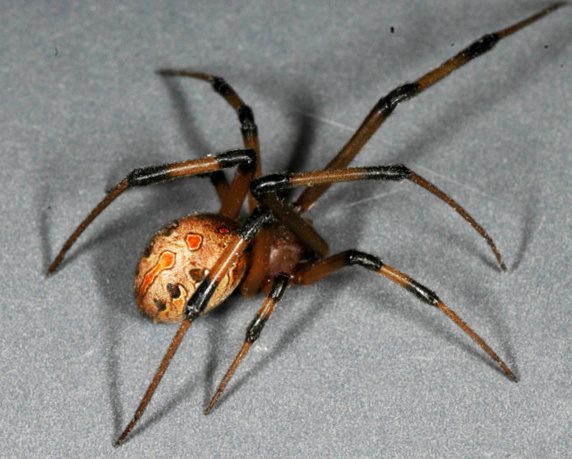
4. Brown Recluse Spider
Due to a dark violin-shaped marking on the head, the brown recluse spider is also known as a fiddle back, fiddler, or violin spider. The spider moves slowly and likes operating in the dark. You are likely to find this spider in clothing, footwear, and bedding. Hiding in such places gets it pressed against your skin, leading to a bite. Brown recluse spiders are no joke because their extremely venomous bite causes massive tissue loss.
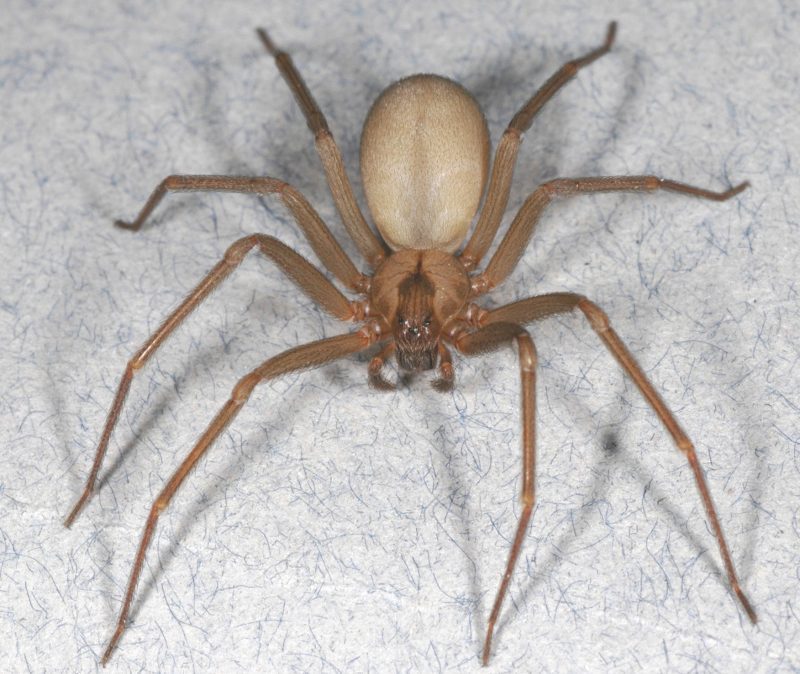
5. Six-Eyed Sand Spider
Mainly found in sandy places, especially deserts, the six-eyed sand spider is medium-sized, measuring around one to two inches. Its legs span up to four inches long. These spiders are closely related to recluse spiders. Despite their poisonous nature, they rarely bite. But when they do, the toxic bite is fatal within five to twelve hours. Severe bite effects include blood thinning, tissue destruction, and blood vessel leakage.
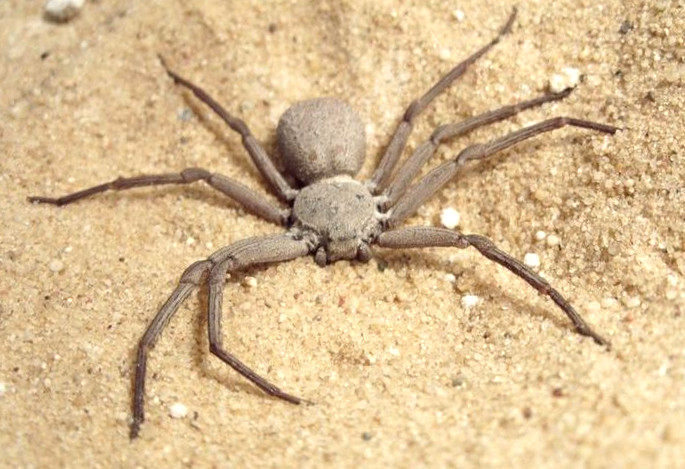
6. Chilean Recluse Spider
Among recluse spiders, the Chilean recluse is the most poisonous spider. That is because its bite is so potent it can lead to fatality. The spider is nonaggressive but bites when touched or trapped. Its venom contains a dermonecrotic agent that causes necrosis of the skin. In extreme cases, a bite can cause severe lesions or even renal failure. 4% of bites are deadly.
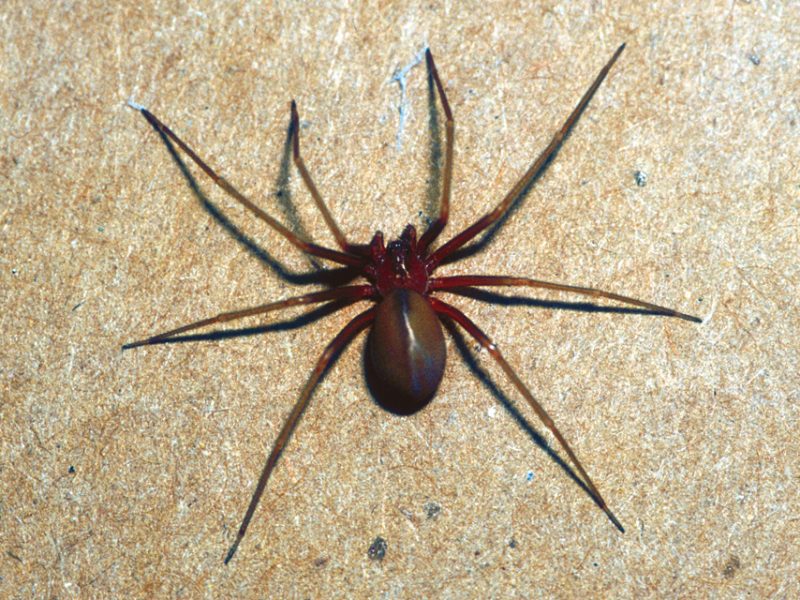
7. Northern Funnel-Web Spider
The northern funnel-web spider grows to a length of about three inches. Such spiders are easily identifiable because they tend to stay in trees. They also love inhabiting places with water. So, you can find them around your swimming pool. Their venom can kill humans within a few minutes if anti-venom is not provided promptly. That makes them one of the world’s most poisonous spiders.
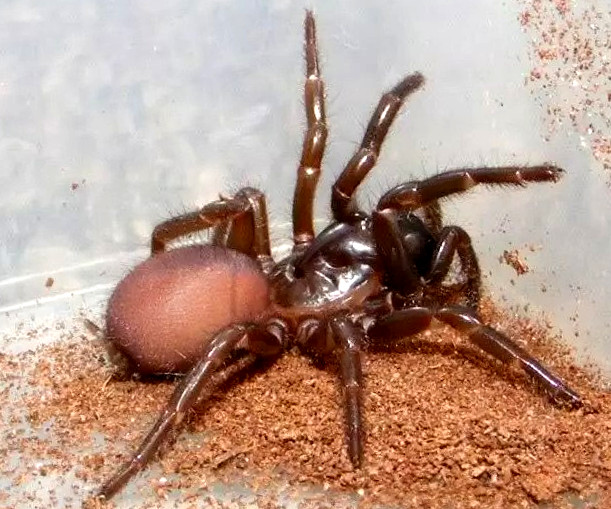
8. Sydney Funnel-Web Spider
Measuring one to three inches long, the Sydney funnel-web spider is among the deadliest spiders on earth. It is very aggressive when rattled and will readily bite. Most of the time, females retreat in silk-lined tubular burrows. During warm months, males are regularly in pursuit of receptive females.
The venom of Sydney funnel-web spiders contains atracotoxin, a very toxic compound. When the spider bites, it delivers full envenomation due to its large fangs and strikes repeatedly because of its high-level aggressiveness. Therefore, avoid approaching such a spider because there is a high risk of getting bitten. A child can die within fifteen minutes of a bite since the venom gets quickly dispersed throughout the body.
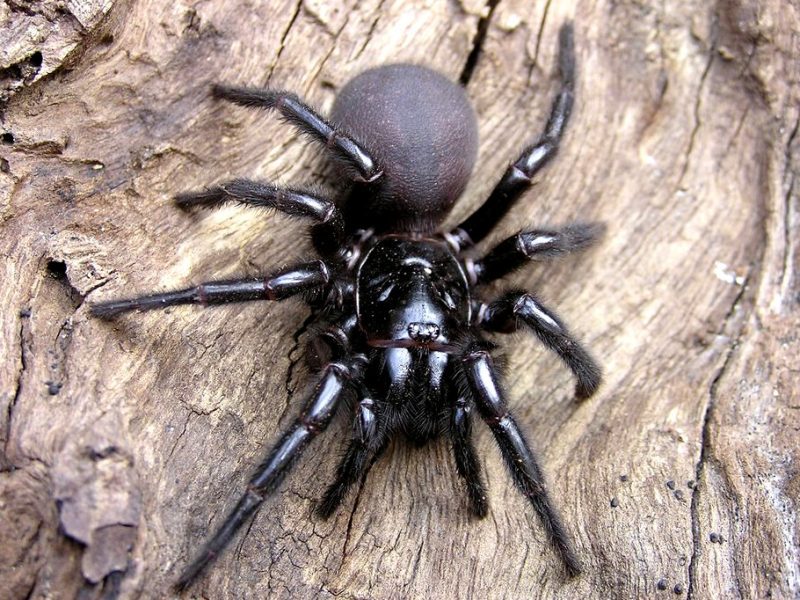
9. Wolf Spider
Wolf spiders measure one or two inches long. Their body is hairy and coloured grey or brown. They have eight eyes arranged in three rows – at the bottom are four small eyes, in the middle are two large eyes and at the top are two medium eyes. Unlike most other spiders, they do not weave webs. But they are aggressive hunters.
Despite being extremely poisonous, the venom of a wolf spider is not that lethal. The spider bites or moves away fast when it feels it is in danger. When you get bitten by this spider, avoid bandaging the bite site. Instead, place an ice pack on it to minimise swelling. And keep calm.
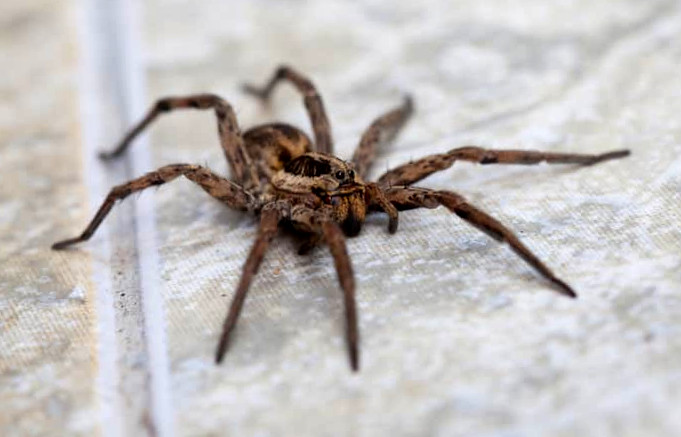
10. Red-Legged Widow Spider
Such spiders are rare but very venomous. They are colourful and less than one inch in length. It takes one to three hours for their bite to take effect. Common symptoms include muscle cramping, severe pain, nausea, hypertension, sweating, and vomiting.
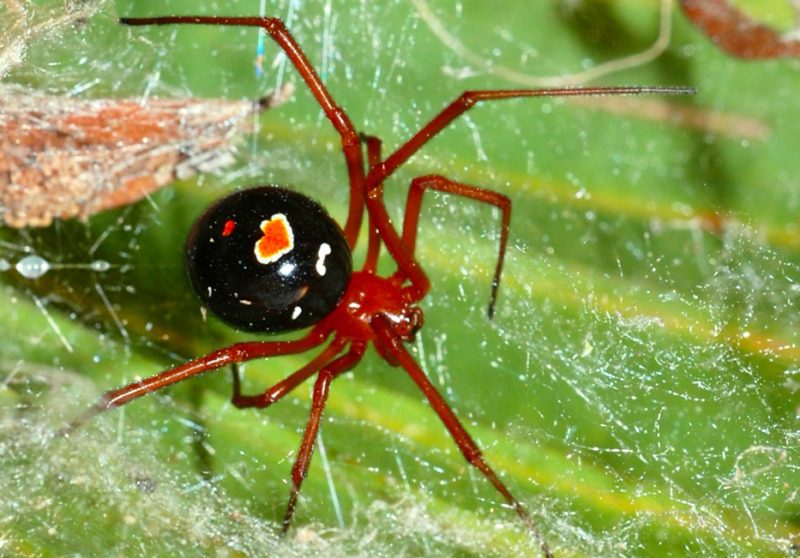
What To Do When Bitten By The Most Poisonous Spiders
When bitten by a poisonous spider, get to a hospital or call your doctor immediately. Most spider bites lead to life-threatening reactions. Acute symptoms include increased heart rate and blood pressure, which cause severe complications. Children, those with health issues, and the elderly are at high risk of severity. If possible, have spider anti-venom at home, which is highly advisable if you live in an area infested by toxic spiders. Overall, preventing spider bites through spider control by a pest control company is the best remedy.
How To Prevent Bites From The Most Dangerous Spiders In The World
- Watch out where you sit or place your hands when outdoors.
- Clear areas spiders love inhabiting, such as rocks and woodpiles.
- Do not leave gloves, boots, and other clothes where spiders can hide unchecked for long.
- Always maintain your lawn or garden to avoid overgrown bushes and long grasses where most poisonous spiders thrive.
- Get rid of spider webs in your house. Make sure there is no spider around when doing this, or else you will get bitten.
-
Most Common Poisonous Household Spiders
August 18, 2021
Spiders are fearsome pests with fangs capable of injecting venom. You can spot them in certain areas in your home,…
Spiders are fearsome pests with fangs capable of injecting venom. You can spot them in certain areas in your home, including the bathroom, basement, and attic or crawl space. While seeing a spider in your house is enough to send chills down your spine, it is good to know that not all spiders are poisonous. They may even help eliminate pests like flies, cockroaches, and mosquitoes. However, it is also worth noting that others are venomous. And here is sufficient information about poisonous household spiders you need to avoid.
1. Black Widow Spider
Black widow spiders are commonly associated with agricultural areas and urban habitats. Females have a bright red mark on their undersides. The red mark is in the form of a dot or an hourglass. Males are shyer, smaller, and less poisonous than females. They are also thin and grey or mottled brown. You will readily find black widows in places with:
- Plenty of food, such as woodlice, flies, and other spiders they prey on.
- A great source of warmth like inside the house.
- Darkness, including inside your shoe closet and under the bed.
Two red marks characterise a bite from a black widow. When venom is injected into your body through the bite, you will experience nausea, fever, muscle spasms, or cramps. Once you get bitten, stay calm and apply direct heat to the bite site to relieve pain and prevent the venom from spreading. Then, seek medical help immediately from an experienced doctor.
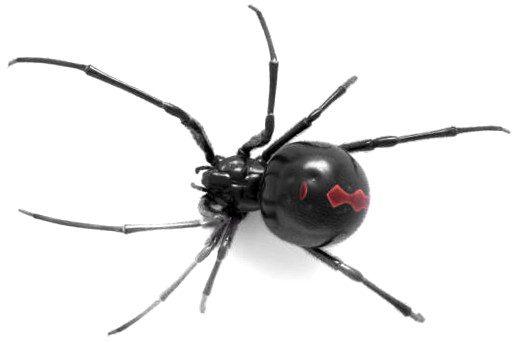
2. Brown Recluse Spider
The brown recluse spider has a smoother appearance than other similar species. It can be challenging to spot this spider due to its dull colour but you can differentiate it from other house spiders by the classic violin mark on the back. Its abdomen does not have any markings, and the legs have no thick hairs. Such spiders prefer inhabiting warm, dark, quiet places. Since they like hiding, it is easy for them to bite without notice.
Brown recluse bites are characterised by red, itchy skin. The bitten area then turns into a blister before worsening and becoming an open sore with tiny red dots. You may also experience nausea and fever. Toxins from the bite may lead to tissue death or necrosis that can take a long time to heal.
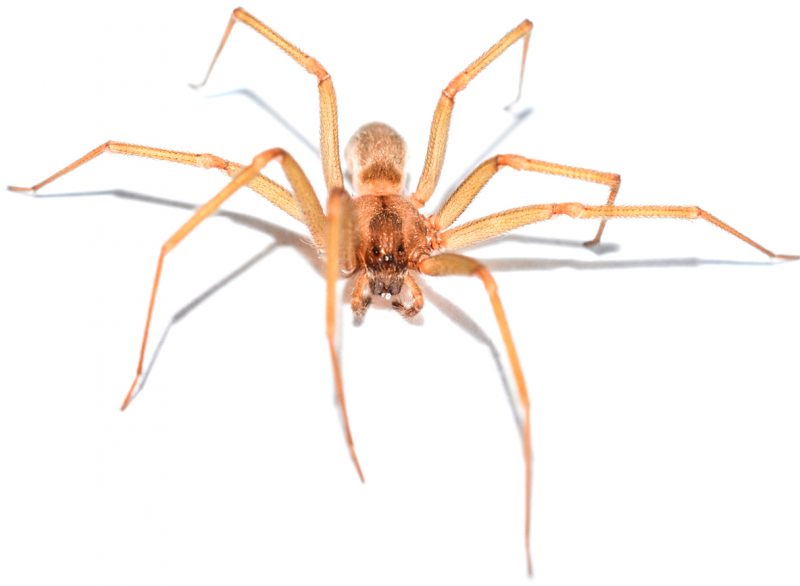
3. Hobo Spider
Hobo spiders are responsible for most spider bites. They have eight eyes and distinctive hairy legs. You can also easily identify them by their mottled colouration and distinctive Herrington pattern. Their common spider bite is painful and can lead to localised red swelling, nausea, fever, and tissue death. Immediate medication is required to ease the symptoms.
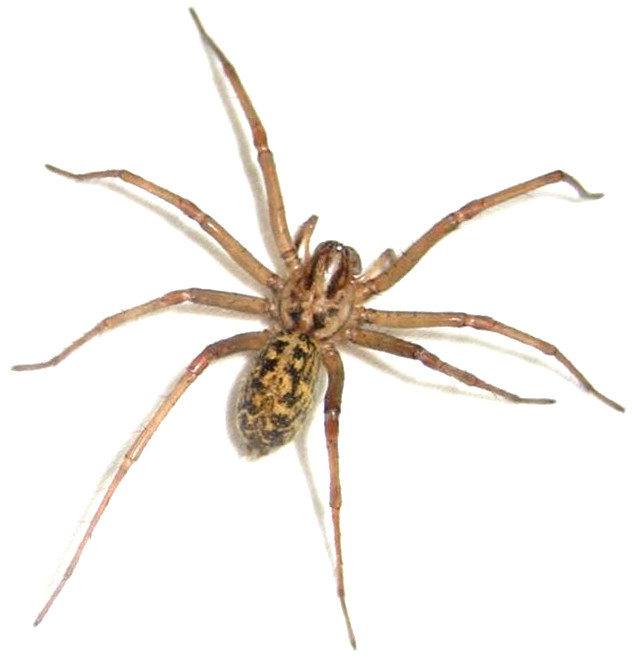
4. Yellow Sac Spider
The yellow sac spider builds a den-like structure from silk. It hides during the day and comes out at night to hunt. As their name suggests, yellow sac spiders feature a yellowish or pale beige pigment. Their body is V-shaped, making them easy to distinguish from other types of spiders. You will likely see them at wall tops in the bedroom, living room, and kitchen.
Yellow sac spiders bite when rattled. A bite from this spider results in a tiny red welt with a mild necrotic centre. Bites also trigger symptoms like nausea, fever, headache, and dizziness. In severe cases, a bite can cause anaphylactic shock.

5. Red House Spider
A red house spider is reddish-brown over its entire body, including the legs. The spider grows as long as 0.2 to 0.3 inches, with adult females being bigger than males. Red house spiders have a spotted body and a rounded stomach shaped like a globe, with females having a red band under the stomach. The red and brown spider accesses your house through holes or cracks before moving to cool and dark spots to nest. You will find its web in the dark corners of your house.
Red house spiders are not aggressive but usually bite when you disturb their web. So, you need to take great care as you clean out spider webs. Their bite is painful but not fatal, nor does it cause a lesion or death of skin cells. You can identify their infestation through remnants of insect prey, eggs sacs, or seeing one of them.

6. Funnel-Web Spider
Recognised as the world’s deadliest spider, this Australia spider is black and grows up to five centimetres long. Funnel-web spiders have a glossy, lightly-haired body. Their bite is deadly for both humans and animals, killing within an hour. The tinier the spider, the more venomous it is.

7. Redback Spider
A redback spider is one of the small house spiders you can quickly identify by its round abdomen featuring a red dorsal stripe. The spider has a neurotoxic venom that causes burning pain. Other symptoms of the bite include sweating, vomiting, and muscle rigidity.
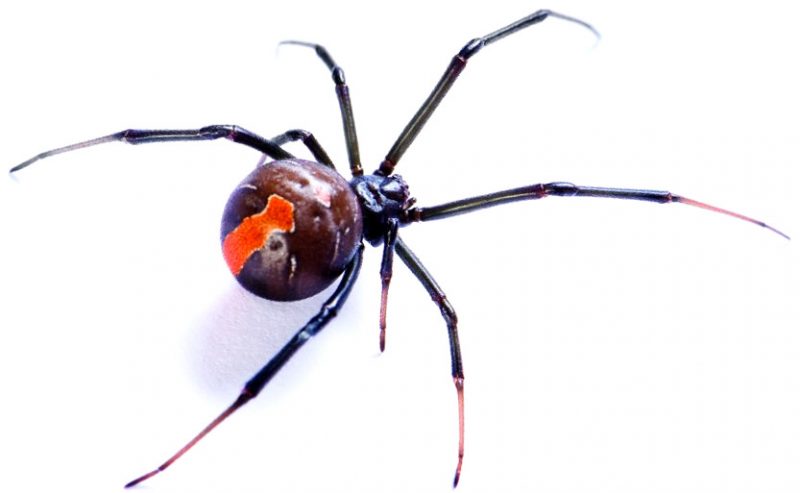
8. Daddy Long-Legs Spider
Daddy longlegs are 7 to 9 mm in length and have very long legs, forming their name. When females lay eggs, they may hold them on the palp until they hatch. The palp is a pair of appendages located near the mouth of a spider and looks like short, leg-like structures. These spiders usually make webs in the house, shed, or garage. They feed on insects and even other spiders. Their bite is toxic. Therefore, seek immediate medical attention if you get bitten.
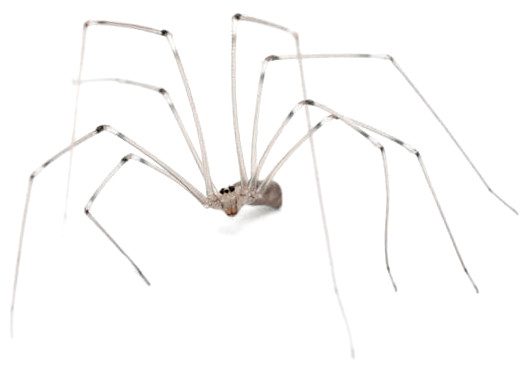
How To Keep Different Kinds Of Spiders Away
If you allow the types of house spiders mentioned above to invade your home, you increase the risk of bites that can be fatal. You keep spiders out of your house by depriving them of all the things that attract them inside. So, sweep and vacuum the attic and basement regularly and pay attention to window sills, wall corners, and ceilings. Another way to prevent them from coming indoors is ensuring that you seal cracks in the walls, floorboards, and foundation. Alternatively, invest in a dehumidifier because most spiders love to live in humid environments and are drawn to moisture-rich places.
Maintaining your lawn is an effective measure towards spider control too. Do this by trimming down bushes, hedges, and branches leaning against the wall cladding. And ensure no foliage touches your house. It is also advisable to repair all rotting and damaged decking or siding. In essence, your indoor and outdoor spaces should be free of debris where poisonous household spiders thrive.
Call A Pest Control Service
Whether harmless or harmful spiders infest your home, you need to get rid of these critters for good. Eliminating spiders may prove challenging due to their poisonous nature and the fear they instil. That is why it is recommended to work with a professional pest management service for safe spider removal. Professionals have years of experience dealing with different types of spiders – be it a big black spider in your house or a giant house spider that is poisonous. They use proven products and practices to eradicate spiders in homes once and for all. For effective and hassle-free spider control, make sure you hire a pest controller in your locality that is reliable and reputable.
-
Do Possums Carry Rabies?
August 18, 2021
Possums are small mammals the size of house cats. They are grey in colour but with a white face and…
Possums are small mammals the size of house cats. They are grey in colour but with a white face and have short legs, a pointed nose, and a long tail. Possums are expert climbers and use their flexible tails for balance and support as they climb. They are usually active at night, thanks to their excellent night vision. During the day, they spend time in hollow trees, brush piles, and spaces under structures. When threatened, possums act lifeless by lying motionless on their side (feet clenched, tongue hanging out, mouth and eyes wide open) and releasing a green secretion from their anus that smells like a rotten carcass.
Are Possums Blind?
Many people think that possums are blind, which is flat-out wrong. Possums are not blind even though they move sluggishly. They have eyes with dilated pupils that enable them to see in the dark.
Are Possums Dangerous?
Although possums are not that destructive, you should not entertain them in your home. They are still considered dangerous because they can:
- Eat Plants – Possums help eliminate pests in your garden. But they can mess up by eating your fruits and vegetables or trampling over your crops.
- Attack Pets – Possums play dead when threatened. If that does not do the trick, they defend themselves by biting. Thus, they can injure your kids and pets if a brawl occurs.
- Kill Chickens – Possums do eat chickens and their eggs, especially when other food sources are scarce.
Can Possums Get Rabies?
The big question is, do possums get rabies and even transmit it? Any mammal can get rabies, and possums are no exception. But possums are at low risk of contracting rabies because of their low body temperature, making it hard for the rabies virus to thrive.
Diseases Transmitted By Possums
While it is unlikely for possums to transmit rabies, they are known disease carriers. Their bodies harbour germs and pathogens that can cause illnesses. Leptospirosis is one of the diseases transmitted through the urine or other body fluids of infected possums. The disease is harmful to both pets and humans. Possums are also linked to various other sicknesses. These include tuberculosis, tularemia, toxoplasmosis, Chagas disease (American trypanosomiasis), relapsing fever, and spotted fever. Besides, they are infested with parasites like lice, fleas, mites, and ticks that are disease spreaders.
Possums In Residential Homes
Possums tend to be opportunists. That is why they invade homes despite them belonging in the woodlands. When you find a possum in your home, note that it is just stopping by to get a meal. Possums love eating cat food and rummaging through garbage. Once they have eaten to their fill, they will leave. But if it is cold outside or breeding season, they will seek shelter in your residence, especially in the attic and under the deck. They can stay there for months if food is readily available. Though possums are troublesome, they are beneficial in eliminating pests like slugs and small rodents.
Signs Of Possum Invasion In Your Home
- Structure Damage – Possums enter buildings by climbing up the siding. Therefore, you will notice exterior damage first. Typical damages include a ripped soffit and torn-up roof shingles. Also, check the eaves and gutter system for damage.
- Pet Food Disappearance – Possums get attracted to pet food. The chances of possum presence in your home are high if cat food keeps disappearing.
- Animal Sounds – Possums have multiple vocalisations, including shrieking and hissing. Females make a clicking or lip-smacking sound as they call their babies. When you hear such sounds around your home, inspect for possible possum presence.
- Unpleasant Smells – An outright sign of possum invasion is the smell. Possums defecate more than any other mammal. And their faeces are larger than those of a cat. The wet droppings soak into building insulation materials leading to an unpleasant smell in your house.
Getting Rid Of Possums
When you find possums in your yard, the best thing to do is to let them be. Within a day or two, they will move somewhere else. However, if you realise they have made your home a permanent dwelling place, you need to take appropriate measures to remove them. Here are some of the ways to deal with possum infestation:
1. Trapping
Trapping involves capturing an animal with a baited trap. Once the animal is trapped, you release it somewhere safe away from your home. It may take a few days before the possums troubling you get trapped. So, be patient.
2. Home Management
Possums invade homes looking for something to eat, including fruits, veggies, small animals, and animal remains. They also search for a cosy place to inhabit. Identify and remove such things and areas that may attract possums to your home.
3. Repellents
Chemical and natural repellents are pretty effective in keeping possums away from your home. They have properties, mainly scents, that these creatures dislike. Though they offer an instant solution, you have to reapply often for effectiveness. Some readily available repellents to use include garlic, ammonia, spicy peppers, and pet fur. These do not harm possums but discourage them from accessing your home.
4. Professional Wildlife Control
The best alternative is getting in touch with a professional wildlife control service. Professionals are knowledgeable in dealing with problems associated with possum invasion. Their expertise removes the guesswork from possum removal. They work by applying the right strategies and utilising the right products that ensure possums are kept at bay.
-
How To Identify Rat Droppings In Your Home
August 18, 2021
Rat and mice infestations are a frustrating experience for homeowners. These rodents enter houses looking for a food source and…
Rat and mice infestations are a frustrating experience for homeowners. These rodents enter houses looking for a food source and nesting place. Through their droppings, you can know if they have infested your home. Identifying rodent droppings is essential in discovering and eradicating an infestation by rats or mice.
What Do Mice Droppings Look Like?
Below we look at the different aspects of rat excreta and how it compares to mice droppings.
1. Colour
Rat droppings are dark brown. The darker the colour, the fresher they are. With time, the droppings dry out and turn grey. You can check the freshness or dryness of rat faeces to determine if you have a current or an old infestation. The same goes for mice poop which is black in colour.
2. How Big Is Rat Poop?
Rat stool differs in size depending on rat age and species. Obviously, the bigger the rat, the more and larger the poop. Rat and mice faeces are different in certain aspects. Mice poop is tinier, darker, and smoother with more pointed ends.
3. How Often Do Rats Poop?
In a day, mice leave behind 80 to 160 droppings, while rats do 40 to 55 droppings. Regardless of the amount, any sign of poop indicates your home has been infested. The quantity of droppings can give you a clue about the number of mice or rats in your home.
4. Moisture
Fresh rodent poop is moist and shiny. To determine how fresh the poop is, use a pointed stick to squish it. If it crumbles, it is old. But if it does not, then it is fresh. Fresh droppings indicate rats and mice are still around.
5. Location Of The Poop
Due to their bigger size, rats defecate in more open areas such as along garage walls, behind storage shelves, under kitchen appliances, and around attic spaces. Mice do the contrary, getting into your cabinet or silverware drawer and easing themselves there.
Rat Vs. Squirrel Droppings
Rat poop is larger than a squirrel’s. It measures around 3/4 of an inch, while that of a squirrel is about 3/8 of an inch. In addition, comparing squirrel poop vs rat poop, the droppings of the former are rounder in shape and lighter in colour.
Dangers Of Rat Faeces
Rat stool contains pathogens that pose several health risks to humans, including Salmonellosis, rat-bite fever, Lymphocytic Choriomeningitis, Leptospirosis, haemorrhagic fever, renal syndrome, Bubonic plague, and Lassa fever. Rat poop can also affect your pets health-wise. When exposed to rat faeces, dogs can contract rat-bite fever, Leptospirosis, Toxoplasmosis, and Tularemia (rabbit fever). The longer it takes to remove rat droppings, the higher the danger posed to your family and pets.
Does Rat Poop Smell?
Rat stool emits a pungent, musky smell. The urine of rats stinks more than their poop.
How Long Are Rat Droppings Toxic?
Whether the poop is dry or moist, it is still hazardous. Rat faeces, old or fresh, can contaminate food, trigger allergies, and spread bacteria. Therefore, there is no specific time frame in which rat faeces remain toxic.
How To Clean Up Rat Poop
When collecting rat faeces for disposal, take precautions not to handle the poop with your bare hands because you will be risking contracting one of the many diseases transmitted by rats. If the faeces are extremely dry and probably crumbled, put a mask on to avoid inhaling airborne pathogens and subsequently getting an allergic reaction. Also, be careful not to contaminate surfaces with the poop.
- Open Windows and Doors – Ventilate the entire space for a few minutes before cleaning up the poop.
- Wear Protective Clothing – Protect yourself from contamination by wearing gloves, a face mask, and goggles. Doing so blocks direct contact with the rat droppings.
- Apply Chlorine Bleach – Mix five litres of hot water with three hundred and sixty millilitres of chlorine bleach. Spray the solution on all areas with rat stool. Do not vacuum or sweep to prevent the release of pathogens into the air.
- Collect the Poop – Use paper towels to pick up the droppings. Put them in a sealed plastic bag and safely dispose of them outside.
- Disinfect Floors and Other Surfaces – Use the chlorine bleach solution to wipe surfaces and then dry using a paper towel.
- Wash Your Hands Clean – With a disinfectant and warm water, thoroughly scrub your hands to ensure no contaminants are left.
Keeping Rats And Mice Away From Your Home
The ideal way to avoid rat and mice droppings is to ensure that these household rodents do not infest your home. Capture them using traps, then release them to the wild. You can also use repellents to drive them away. Some effective rodent repellents include peppermint oil, hot pepper flakes, garlic, clove oil, ammonia, and instant potatoes. However, if the rat or mice infestation is severe, it is strongly recommended to contact a professional rodent control service. Specialists in rodent removal eradicate rats and mice in homes, getting rid of their droppings altogether.
-
How To Differentiate Between Rat And Mice Droppings
August 18, 2021
Mice and rats are nocturnal rodents. They are mostly active at night when many of their predators are asleep. Their…
Mice and rats are nocturnal rodents. They are mostly active at night when many of their predators are asleep. Their nightly nature poses a challenge because you cannot spy on them. So, how do you know you have a rat or mice infestation? The clearest indication is mouse or rat droppings. Besides looking different and having distinct behaviours, rats and mice can be differentiated by their poop. To determine whether mice or rats infest your home, it pays to tell the difference between rat poop vs. mice poop.
Rat Droppings Vs. Mouse Droppings
1. Rat Droppings
A rat infestation can deposit at least twenty to forty droppings daily. Rats also produce a large amount of pungent-smelling urine. Within a few weeks of infestation, the smell emanating from the droppings can be recognised upon entering the house. Rat poop usually appears in tight, large clusters because rats defecate in the same place.
Where To Find Rat Poop
- Boiler rooms, storage cupboards, and inspection chambers
- Beneath kitchen and utility room appliances
- Behind dryers, fridges, freezers, and washing machines
- Insulated lofts, attics, and crawl spaces
2. Mouse Droppings
Mice can produce fifty to seventy-five black, scattered droppings in a single night. The droppings almost look similar to those of bats. The main difference is that bat droppings usually crumble to dust, while mice have putty-like droppings. Like rats, mice urinate a lot with the urine featuring a pungent smell and containing disease-causing bacteria. Unlike rats, mice defecate all over the place.
Where To Find Mice Poop
- In sofa beds
- Inside toaster and crumb trays
- Under microwaves and TV cabinets
- Behind and beneath furniture
3. Size Of The Droppings
Rat droppings are bigger than those of mice, measuring three-quarter inches long and featuring a blunter end. How big is mouse poop then? Mice droppings measure around a quarter-inch in length and feature a pointed end.

4. Shape And Colour Of The Droppings
Rat poop is dark brown and wide, featuring a banana-like curve. On the other hand, mice poop is black with a granular shape.
5. Location Of The Poop
Mice usually build their nesting place close to food sources like the pantry, and here is where you are likely to find their droppings. Rats tend to put up nests in more hidden areas, such as behind the wall or along the basement. If you find poop in such locations, it likely belongs to rats.
What Do Rat And Mice Droppings Indicate?
When you spot rat or mouse poop in your house, it simply means there is an infestation. The size and amount of poop can help you determine how many rodents have invaded your home and how large they are. And rat vs. mouse poop differences will enable you to know which of the two common household rodents has infested your home. The frequency of pooping indicates whether rats and mice are still active or not.
A baby rat or mouse produces tiny droppings. Hence, if you spot countless droppings differing in size, it signifies that mice or rats are actively reproducing. The age of the poop, whether fresh or dry, confirms current or past activity by rats or mice. Fresh poop shows that they are still around, while dry poop shows they were around but have since left or died. If you are not sure, clean up the old droppings and check if new poop will appear within a day or two.
Health Risks Of Mouse And Rat Droppings
Both mice and rat droppings are health hazards despite their many differences. The droppings are linked to various diseases, including Leptospirosis, Rickettsia, Salmonellosis, and Hantavirus. Therefore, it is dangerous having direct contact with rat and mouse poop. Again, with time, the droppings dry and crumble, becoming airborne. When inhaled, an allergic reaction may occur.
Proofing Your Home
Securing your home against household rodents is the finest way of doing away with rat and mice droppings once and for all. Trim all shrubs and trees around. Keep bird feeders away from your house. And store pet food indoors, preferably in plastic or metal rodent-proof containers. Additionally, check the exterior of your home for cracks, crevices, and other entry points rats and mice can use to gain entry.
Hiring A Rodent Control Expert
Now that you are knowledgeable about rat poop vs. mouse poop, what next? Rat and mice control it is! It is advisable to get in touch with a professional rodent control service to successfully deal with a rat or mice infestation in your home. Professionals not only eliminate the mice and rats on your property but also clean up their mess. If you are experiencing a small infestation, you can use traps and other DIY approaches to get rid of these furry pests. Items in your pantry like cloves, black pepper, cayenne pepper, and peppermint oil are favourable rodent repellents.
